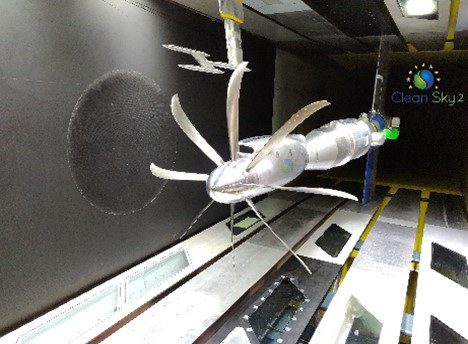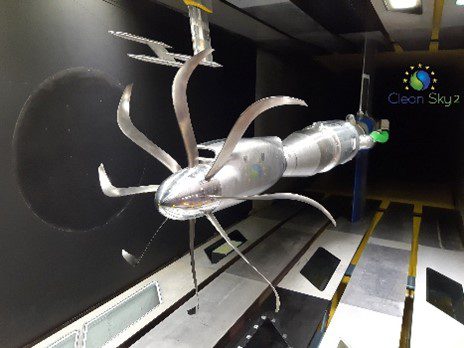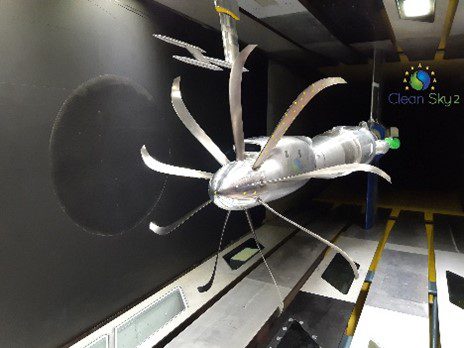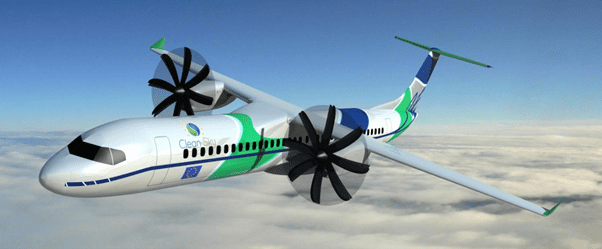Researching innovative, low-noise propeller designs.
The IRON project falls under Europe’s Clean Sky 2, sitting within the larger regional aircraft package. One aspect of the project looks at carrying out design studies of innovative propeller concepts with the aim of significantly reducing noise levels without degrading aerodynamic performance. The project is coordinated by CIRA, the Italian Aerospace Research Centre, with Leonardo positioned as topic leader supported by several core partners from all over Europe such as GE Aviation Advanced Technology (AAT) Deutschland, Dowty Propellers – UK, CENAERO – Belgium, NLR – Netherlands, ONERA – France and Avio Aero – Italy.
Europe has recently voiced very high ambitions for reducing Aircraft community noise, with the Advisory Council for Aviation Research and Innovation in Europe (ACARE) pushing for a 65% noise reduction by 2050 compared to the situation in 2000. More than simply an annoyance to people living nearby, the World Health Organization identifies aircraft noise as an ‘underestimated threat’ that can cause short and long-term health problems. Noise also has a huge impact on airline operations due to increasingly stricter regulation and charges imposed by airports. Airlines try to avoid landing at night-time where possible to avoid noise-based charges imposed on later landings such as at London Gatwick, where noise charges can be up to 20 times more during the night.
Clearly, innovative low-noise designs will be needed to reach Europe’s ambitious long-term targets and propeller technologies must keep advancing to fulfil the needs of the industry. Therefore, if turboprops are to be the future of regional flight, then initiatives such as those within the IRON project are crucial in ensuring that similar targets are achieved without compromising on performance.
Turboprop aircraft typically produce around 95% of their thrust from a propeller, with a jet exhaust providing the rest. With this split it won’t be a surprise that most of the noise generated by a turboprop is generated by the propeller itself. As the propeller spins, the speed at which the tips are moving is high, sometimes transonic, and the disruption to the airflow creates pressure fluctuations that result in a series of low frequency tones that the human ear is more sensitive to, leading to the perception of a noisier cabin for passengers. As such, the IRON project has focused on the design and testing of new, innovative propellers, setting the ambitious target of a 6 dB near-field noise reduction at cruise compared to a baseline design.
The baseline propeller design was developed by Dowty Propellers based on today’s mature technology and was focused on delivering maximum efficiency and minimal mission fuel burn. Furthermore, the baseline was also designed to meet the community noise requirements set by Leonardo.
IRON Turboprop aircraft
The maximised performance of Dowty’s propeller means that the other partners’ task of trying to achieve a 6 dB cabin noise reduction without compromising the baseline’s performance level was extremely challenging and would require the application of innovative, low maturity technologies. Dowty, with support from Leonardo and Avio Aero, generated the propeller requirements to ensure, as a minimum, the delivery of a practical propeller design suitable for the next stage of test evaluation while managing the classic propeller design trade-off between performance and noise. This required concurrent engineering analyses to cover aerodynamics, acoustics and structural modelling. These requirements were linked to a scoring system established to allow some design flexibility around the objective to maintain the mission fuel burn of the baseline propeller and aircraft configuration. The scoring system was weighted towards the noise reduction at cruise in the near-field and supplemented by community noise conditions. Conversely, significant penalties to the score were imposed for a reduction in aircraft fuel burn (including the impact of the weight of the propeller system in addition to aerodynamic performance) which had to remain within 1% of the baseline.
From the five designs produced by the IRON partners, the two designs with the highest scores were selected for comparative wind tunnel testing against the baseline: one 9-blade propeller from GE AAT Deutschland and an 8-blade design from CENAERO.



Wind tunnel models in the high-speed (HST) wind tunnel (From left to right: Baseline, CENAERO, GE AAT Deutschland)
Testing and Development
These selected designs were the result of a multi-disciplinary approach to the problem with highly three-dimensional shapes. The team at NLR was tasked with the challenge of transforming these designs into 1:6 scale models, using state of the art manufacturing techniques. Titanium was chosen as the material due to its high strength to weight ratio, important because of the high loads put on the models during testing.
With the models made, the designs were tested in both high and low speed wind tunnels at speeds of up to Mach 0.58 and over 5000 rpm (increased by factor of 6 due to the scale of the models). High speed testing was conducted at DNW’s High Speed Tunnel (HST) facility and was used to simulate climb and cruise aerodynamic and acoustic performance (fuel burn assessment and 6dB cruise noise reduction target). In addition, low speed testing was performed at DNW’s Large Low-speed Facility (LLF), focusing on take-off performance and community noise.

The highly complex task of performing the tests and the huge volume of data captured means data analysis is still ongoing (100 test parameters at over 300 operating conditions involving the use of 200 microphones and other sensors). However, preliminary results indicate that the high-level objectives of the project are on track and that the innovative propellers have significant noise reduction. The benefits of the testing extend beyond the immediate task of verifying the noise reduction of the new designs, with both ONERA and CIRA planning to use the data collected to validate high fidelity computational models able to capture the unsteady aero-acoustic behaviour of an installed propeller.
More development work is required to transition the innovative designs and technologies of the IRON project into practical, producible designs meeting all the requirements of a modern propeller system but the technology has been demonstrated and the challenge to make the associated benefits available to next generation regional aircraft is set.

